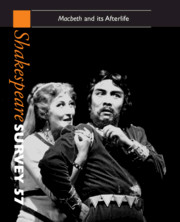Book contents
- Frontmatter
- Humane Statute and the Gentle Weal: Historical Reading and Historical Allegory
- Macbeth’s Knowledge
- ‘The Grace of Grace’ and Double-Talk in Macbeth
- Remind Me: How Many Children Had Lady Macbeth?
- Taking Macbeth out of Himself: Davenant, Garrick, Schiller and Verdi
- ‘Two truths are told’: Afterlives and Histories of Macbeths
- Doing All That Becomes a Man: The Reception and Afterlife of the Macbeth Actor, 1744–1889
- Macbeth and Kierkegaard
- Monsieur Macbeth: from Jarry to Ionesco
- The Politics of Sleepwalking: American Lady Macbeths
- Macbird! and Macbeth: Topicality and Imitation in Barbara Garson’s Satirical Pastiche
- Mick Jagger Macbeth
- ‘The Zulu Macbeth’: The Value of an ‘African Shakespeare’
- ‘A Drum, a Drum – Macbeth doth come’: When Birnam Wood moved to China
- The Banquet of Scotland (PA)
- Scoff power in Love’s Labour’s Lost and the Inns of Court: Language in Context
- Mercury, Boy Yet and the ‘Harsh’ Words of Love’s Labour’s Lost
- Shakespeare, Sir Thomas More and Asylum Seekers
- Hal as Self-Styled Redeemer: The Harrowing of Hell and Henry IV Part 1
- Mr Hamlet of Broadway
- Shakespeare Performances in England, 2003
- Professional Shakespeare Productions in the British Isles January–December 2002
- The Year's Contributions to Shakespearian Study 1 Critical Studies
- 2 Shakespeare in Performance
- 3 Editions and Textual Studies
- Books Received
- Index
‘Two truths are told’: Afterlives and Histories of Macbeths
Published online by Cambridge University Press: 28 March 2007
- Frontmatter
- Humane Statute and the Gentle Weal: Historical Reading and Historical Allegory
- Macbeth’s Knowledge
- ‘The Grace of Grace’ and Double-Talk in Macbeth
- Remind Me: How Many Children Had Lady Macbeth?
- Taking Macbeth out of Himself: Davenant, Garrick, Schiller and Verdi
- ‘Two truths are told’: Afterlives and Histories of Macbeths
- Doing All That Becomes a Man: The Reception and Afterlife of the Macbeth Actor, 1744–1889
- Macbeth and Kierkegaard
- Monsieur Macbeth: from Jarry to Ionesco
- The Politics of Sleepwalking: American Lady Macbeths
- Macbird! and Macbeth: Topicality and Imitation in Barbara Garson’s Satirical Pastiche
- Mick Jagger Macbeth
- ‘The Zulu Macbeth’: The Value of an ‘African Shakespeare’
- ‘A Drum, a Drum – Macbeth doth come’: When Birnam Wood moved to China
- The Banquet of Scotland (PA)
- Scoff power in Love’s Labour’s Lost and the Inns of Court: Language in Context
- Mercury, Boy Yet and the ‘Harsh’ Words of Love’s Labour’s Lost
- Shakespeare, Sir Thomas More and Asylum Seekers
- Hal as Self-Styled Redeemer: The Harrowing of Hell and Henry IV Part 1
- Mr Hamlet of Broadway
- Shakespeare Performances in England, 2003
- Professional Shakespeare Productions in the British Isles January–December 2002
- The Year's Contributions to Shakespearian Study 1 Critical Studies
- 2 Shakespeare in Performance
- 3 Editions and Textual Studies
- Books Received
- Index
Summary
Shakespeare’s Macbeth made an immediate impression on his Jacobean contemporaries. Within a year or two of its first performance (late 1605 – early 1606, according to most scholars), one of the play’s key scenes – the appearance of Banquo’s ghost in 4.1 – had already been alluded to in Middleton’s The Puritan, or the Widow of Watling-Street, and parodied in Beaumont’s The Knight of the Burning Pestle, when Jasper enters, ‘his face mealed’ (5.1.4 sd). Thomas Middleton seems to have been involved in making additions to Shakespeare’s text – the songs in 3.5 and 4.1, and possibly more – after 1609. In 1611, Simon Forman recorded details of a performance of the play at the Globe Theatre, including the evidently memorable scene of Banquo’s ghost appearing, in addition to extensive commentary on the witches and their prophecies, and Lady Macbeth’s sleepwalking scene. After the Restoration, Davenant’s adaptation of Shakespeare’s Macbeth (1673) became highly successful – Pepys recorded attending multiple performances – and inspired its own parody by Thomas Duffet in 1674. A succession of the greatest actors and actresses of the late seventeenth and eighteenth centuries performed the lead roles. By the twentieth century, Shakespeare’s Macbeth had become the sole origin of what might be called ‘Macbeth-discourse’, the only version of the story known to most readers and audiences; famous lines and scenes from the play had entered the general cultural lexicon as suitable for appropriation by commercial and other interests, and a feature film released in 2000, Scotland, PA, resituated the play to a fast-food restaurant in America.
- Type
- Chapter
- Information
- Shakespeare SurveyAn Annual Survey of Shakespeare Studies and Production, pp. 69 - 80Publisher: Cambridge University PressPrint publication year: 2004
- 1
- Cited by



